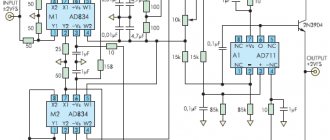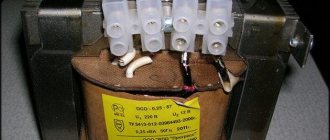What is alternating current: definition
Everyone has heard this term, but not everyone knows what it means. Variable is the chaotic movement of charged particles, changing its polarity from plus to minus with a certain frequency, which is measured in hertz (Hz). If you draw a graph, then such a value will look like a sinusoid periodically crossing the “X” coordinate axis. If we talk about three-phase current, then it flows not through one conductor, but through three. The phase sinusoids are ideally completely identical, but shifted relative to each other by 120 degrees.
Alternating current is found everywhere. It is produced at power plants by generators with various drives. Such current is easy to transmit over various distances and it is quite easy to obtain a constant current from it, which cannot be said about the reverse transformation. For “transportation” with minimal losses, the voltage is increased to 25 kV, as a result of which, according to the laws of physics, the current strength, measured in amperes (A), is reduced. When it reaches the desired point, it goes to the primary transformer substation. The voltage on it is reduced to 6 kV and sent further. The last transformer further reduces the voltage to the usual 0.4 kV (400V). It is this current that enters apartment buildings in three phases. Here the phases are evenly distributed, as a result of which 1 phase is supplied to each dwelling, capable of providing the premises with an electrical voltage of 220 V.
So what is the current in the outlet? Of course it is variable. Almost all household appliances work on it. If the device requires direct current, special transformers with rectifiers (diode bridges), called adapters, are used. Televisions, computers, and stereo systems are often equipped with similar power supplies.
Alternating and direct current: what is the difference, history of development, application
Children are taught that they should not stick their fingers into electrical sockets! And why? Because it will be bad. There are often problems with a more detailed explanation: there is some kind of voltage, current, something is flowing somewhere. So that in the future you can explain to your children what’s what, we will now explain to you. This article is about alternating and direct currents, their differences, applications and the history of electricity in general. Science needs to be made interesting, and we modestly try to do this to the best of our ability.
For example: what current is in our sockets? Variable, of course! Voltage 220 Volts and frequency 50 Hertz. And the network through which the current is transmitted is three-phase. By the way, if at the words “phase” and “zero” you fall into a stupor, read what it is, and the day will be lived doubly not in vain! But let's not get ahead of ourselves. First things first.
Daily newsletter with useful information for students of all directions - on our telegram channel.
A Brief History of Electricity
Who invented electricity? And no one! People gradually understood what it was and how to use it.
It all started in the 7th century BC, on one sunny (or maybe rainy, who knows) day. Then the Greek philosopher Thales noticed that if you rub amber on wool, it will attract light objects.
Then there were Alexander the Great, wars, Christianity, the fall of the Roman Empire, wars, the fall of Byzantium, wars, the Middle Ages, the Crusades, epidemics, the Inquisition and more wars. As you understand, people had no time for any electricity or ebonite sticks rubbed with wool.
In what year was the word “electricity” invented? In 1600, the English naturalist William Gilbert decided to write the work “On the Magnet, Magnetic Bodies and the Great Magnet - the Earth.” “electricity” appeared .
One hundred and fifty years later, in 1747, Benjamin Franklin, whom we all love very much, created the first theory of electricity. He viewed this phenomenon as a fluid or immaterial liquid.
It was Franklin who introduced the concept of positive and negative charges (before that, glass and resin electricity were separated), invented the lightning rod and proved that lightning is electrical in nature.
Everyone loves Benjamin, because his portrait is on every hundred dollar bill. In addition to his work in the exact sciences, he was a prominent political figure. But contrary to popular belief, Franklin was not the President of the United States.
Next will be a list of discoveries important for the history of electricity.
1785 - Coulomb finds out with what force opposite charges attract and like charges repel.
1791 - Luigi Galvani accidentally noticed that the legs of a dead frog contracted under the influence of electricity.
The operating principle of the battery is based on galvanic cells. But who created the first galvanic cell? Based on Galvani's discovery, another Italian physicist Alessandro Volta created the Volta column in 1800, the prototype of the modern battery.
At excavations near Baghdad, they found a battery more than two thousand years old. What ancient iPhone was recharged with its help remains a mystery. But we know for sure that the battery has already run out. This case seems to say: maybe people knew about electricity much earlier, but then something went wrong.
Already in the 19th century, Oersted, Ampere, Ohm, Thomson and Maxwell made a real revolution. Electromagnetism was discovered, induced emf, electrical and magnetic phenomena were linked into a single system and described by fundamental equations.
By the way! If you don’t have time to deal with all this yourself, our readers are now offering a 10% discount on any type of work
The 20th century brought quantum electrodynamics and the theory of weak interactions, as well as electric cars and ubiquitous power lines. By the way, the famous Tesla electric car runs on direct current.
Of course, this is a very brief history of electricity, and we have not mentioned very many names that influenced progress in this field. Otherwise, a whole multi-volume reference book would have to be written.
D.C
First, recall that current is the movement of charged particles.
Direct current is current that flows in one direction.
A typical DC source is a galvanic cell. Simply put, a battery or accumulator. One of the oldest artifacts related to electricity is the Baghdad battery, which is 2000 years old. It is believed that it provided a current of 2-4 Volts.
Where is DC used:
- in powering most household appliances;
- in batteries and accumulators for autonomous power supply of devices;
- for powering car electronics;
- on ships and submarines;
- in public transport (trolleybuses, trams).
The easiest way to represent direct current is visually, on a graph. Here's what it looks like:
D.C
Household appliances operate on direct current, but alternating current comes into the network sockets in the apartment. Almost everywhere, direct current is obtained by rectifying alternating current.
Direct current: features
Its strength and direction are unchanged. Here, conductors carry a certain charge - positive or negative. In everyday life, not only adapters are responsible for generating DC current. It can be obtained from batteries and galvanic cells. DC voltages in everyday life are small - usually from 1.5 V to 24 V.
In industry it is used for motors with high starting currents. This allows for smooth adjustment of the rotation speed. Here, direct current is generated by special generators that create vortex flows of the electromagnetic field.
Types of current
There are two types of current - direct and alternating. To understand the difference and determine whether the outlet has direct or alternating current, you should delve into some technical features. Alternating current has the property of changing in direction and magnitude. Direct current has stable qualities and direction of movement of charged particles.
Alternating current comes out of the power plant generators with a voltage of 220-440 thousand volts. When approaching an apartment building, the current is reduced to 12 thousand volts, and at the transformer station it is converted to 380 volts. The voltage between phases is called linear. The low-voltage section of the step-down substation produces three phases and a zero (neutral) wire. Energy consumers are connected from one of the phases and the neutral wire. Thus, single-phase alternating current with a voltage of 220 volts enters the building.
The distribution diagram of electricity between houses is presented below:
In the home, electricity is supplied to the meter, and then through automatic machines to the boxes of each room. The boxes contain wiring throughout the room for a couple of circuits - electrical outlets and lighting equipment. The machines can be provided one for each room or one for each circuit. Taking into account how many amperes the outlet is designed for, it can be included in a group or connected to a dedicated circuit breaker.
Alternating current accounts for approximately 90% of all electricity consumed. Such a high specific gravity is due to the peculiarities of this type of current - it can be transported over considerable distances by changing the voltage at substations to the required parameters.
Sources of direct current are most often batteries, galvanic cells, solar panels, thermocouples. Direct current is widely used in local networks of automobile and air transport, in computer electrical circuits, automatic systems, radio and television equipment. Direct current is used in contact networks of railway transport, as well as on ship installations.
Note! Direct current is used in all electronic devices.
The diagram below shows the fundamental differences between direct and alternating currents.
What You Should Know About Amperage and Voltage
It is not enough to know what current is in the outlet - alternating or direct. There are many other factors to consider. Many people believe that the higher its voltage, the more dangerous it is. In fact, everything is quite the opposite. As already mentioned, with increasing voltage the current strength decreases, and in case of damage, this parameter is dangerous for the body. But this statement is true only for a constant value. Alternating current does not have a specific strength - this parameter will depend on the load. The more devices are plugged into a 220-volt electrical outlet, the higher this value is in the conductor. The increase in this parameter will be limited by automatic protective equipment, which will not allow the current strength to increase to critical limits, turning off the power to the home network.
What current flows into the outlet: characteristics of household voltage
The standard voltage of a household network between phase and neutral is 220-240 V. The current strength depends on the number of consumers and their characteristics. Let's try to calculate the parameters when connecting a washing machine with a water heater with a power of 2.5 kW. To find out what current strength will be present in the outlet when connecting such equipment, it is necessary to clarify some values. For calculations you will need the power factor. It is indicated in the technical documentation and on the device nameplate. If this indicator is missing, a value of 0.95 is taken for calculation.
To find out the current strength that occurs when the water heater is turned on, you need to multiply the voltage by the power factor, and then divide the 2.5 kW that the washing machine consumes by the resulting value. The calculations will look like this: 2500 W / (220 × 0.95) = 11.96 A. It turns out that a regular cheap 220 V electrical outlet will not be suitable for such equipment - its maximum is 10 A. You will have to purchase a more expensive product that can withstand up to 16 A.
Safety automation: how it can save lives
By rewriting all the data of household appliances connected to a certain line, you can determine what current is generated in household sockets when all equipment is turned on at the same time. This will allow you to select protective devices with suitable parameters. Many people underestimate the role of RCDs in the power supply circuit, believing that a conventional circuit breaker is quite sufficient. However, these devices have completely different purposes.
The circuit breaker is designed to force or emergency open the circuit in the event of an overload or short circuit. But it is not able to protect a person from electric shock if the insulation of a current-carrying conductor is damaged and it comes into contact with open areas of the body. But this work is successfully performed by the RCD. If the room is equipped with sockets with grounding, then in the event of a breakdown, a current leak occurs, which is detected by the residual current device, instantly interrupting the power supply. The only problem with an RCD is that it does not respond to a short circuit, as a result of which it can burn out. It is for this reason that the residual current device is mounted in conjunction with a circuit breaker.
Mains voltage and its changes
It is clear that the question of how many amperes the current is in an outlet is incorrect - this is a changeable quantity. But why can the voltage in the network drop or rise sharply? Most often, there are two reasons for the occurrence of such problems - a worn-out transformer at the substation that requires replacement and unqualified electricians who disconnected the phases before putting the house into operation. If everything is more or less clear with the first option, then it is worth dwelling on the second in more detail.
What is electric current
Everyone knows from the school physics curriculum that current is the directed movement of electrons. In all power plants, the principle of generating electricity is the same. To do this, it is necessary that the shaft of the rotor unit rotates. Essentially, it is a bundle of copper that is located between two magnets. You can rotate the shaft using water, wind, hot air (steam) and so on. That is why power plants are divided into types: hydro, wind, thermal, and so on.
Why are magnets needed? With their help, electrons inside the copper begin to move due to the generated magnetic field, forming a directed movement, that is, a current flow. To release electrons, a wire is connected to the copper, which drains the current from the installation.
But why is the current generated by a power plant called alternating? It's all about changing the direction of electron movement. There are indicators such as current frequency and voltage. So in domestic electrical networks, the current frequency is 50 Hz and the voltage is 220 volts. The frequency indicates that in one second the current changes its direction 50 times, and accordingly the charges of the particles from positive to negative. As for voltage, it is essentially the pressure or pressure of electrons in the network.
So, alternating current is a change of charges. Therefore, the voltage changes from maximum to minimum and vice versa 50 times within one second, for a total of 100 times. Either it becomes maximum (100%), then minimum (0%). And this cycle repeats itself all the time. If the voltage in the network was always constant, and at the same time maximum, then wiring it would require an electrical cable of huge cross-section. This is not necessary with variables. A small diameter wire can transmit millions of volts.
Causes of phase imbalance and its consequences for household appliances
If there are three apartments on the site, then the connection is made as follows - a common zero for all rooms and one of three phases for each. In this case, the riser is replaced on each floor. If in the first phase the third phase is connected to a two-room apartment, in the second it will go to a four-room apartment, and even higher it will power a one-room apartment. This alternation allows you to evenly distribute the load. If you run one phase through all the four-room apartments of the entrance, and even imagine a cold winter with the need to use electric radiators, it is easy to understand how the network is overloaded. In this case, the line voltage may drop. Due to phase imbalance, additional load will be placed on the transformer.
Now let’s imagine that people are returning from work (usually at the same time), it’s warmer outside, so the radiators in several apartments are turned off at once. The result is predictable - a power surge and possible failure of household appliances. This often happens in apartments with incorrectly selected automation and a lack of grounded sockets.
Some tips for choosing RCD and AB sockets
The first step is to write down separately the power of all household appliances, dividing them into groups from which they will be powered. By calculating what current in the outlet will be maximum, you can determine the parameters of the circuit breaker and RCD required for a particular line. If a general residual current device is planned, then all current indicators are added up. This is quite acceptable, but it should be remembered that each group must have a separate circuit breaker. It is installed after the RCD, which is powered by an electricity meter. Here, between the meter and the residual current device, it is necessary to install a common circuit breaker. It will protect the RCD in case of a short circuit or heating of the wiring. Another place for mandatory installation of an automatic or batch switch is in front of the electric meter. It is used when it is necessary to replace or service a metering device.
Sockets
So, let's move on to the topic of what current is used in the outlet: direct or alternating. Let's move on to sockets, because they appear in the question. So, are there sockets for constant voltage and alternating voltage? Let's say right away that there is. How are they different from each other?
Let's start with the fact that sockets in which alternating voltage is present are indicated by the symbol (
) or letters of the Latin alphabet (AC), that is, Alternating Current, which is translated from English as alternating current.
DC outlets are identified by a (–) symbol or the letters DC (Direct Current). In the diagrams, such sockets are indicated by a plus and a minus with an arrow. Let’s immediately make a reservation that it is useless to plug ordinary household appliances into an outlet where there is constant voltage. They still won't work. Pay attention to the figure below, where the icons are indicated.
So, many manufacturers put them on sockets for ease of recognition, that is, what voltage they are intended for. As you can see, even purely visually you can determine what voltage is in the outlet: constant or alternating. Of course, all these are nuances, because domestic networks supply only alternating current, so there is no need to even look at what markings the outlet has, whether there are special symbols or not.
Summing up
Information on the question of what current is in the socket has become clear - variable. Its value is not determined and depends only on the power consumption of household appliances connected to the network. The network voltage is 220-240 V. For a home handyman who is not professionally involved in electrical engineering, these characteristics are quite enough. If you need to calculate the current strength in your home network at full load, you can always use the calculations presented in the article. This may be necessary to select protective automation with the necessary parameters, as well as when completely replacing electrical wiring.
Methods for measuring voltage and current
To check whether the voltage of the electrical network meets the established requirements, and also to find out how many amperes flow through one or another element, various instruments are used to measure current and voltage.
Indicator screwdriver
The cheapest device that allows you to check the presence of potential on the socket contacts is an ordinary indicator screwdriver. However, it is impossible to find out how many volts are applied between the contacts.
In a normally operating network, when the indicator touches the phase contact of the socket, the LED built into the handle of the voltage indicator glows brightly; when it touches the neutral wire, there is no such glow. This method can only be used to determine the presence of voltage in a phase wire.
Its significant disadvantages are the inability to control the integrity of the neutral conductor, the voltage level, as well as the susceptibility of measurement accuracy to the influence of “noise” created by the magnetic fields of electrical wires passing nearby. Thus, the indicator can light up even if there is no rated voltage at the phase contact of the socket.
Tester
A more accurate way to measure voltage is to use special devices - voltmeters (testers or multimeters are often used that allow you to measure several quantities: voltage, current, resistance, capacitor capacity, etc.).
Such a device is connected in parallel to the network (its probes are inserted into the socket when there are no consumers connected to it). Using such devices, you can find out how many volts of direct or alternating voltage are applied to the contacts of the outlet.
The current in a socket can be measured using a multimeter connected in series with the network as an ammeter.
Important! A device configured to measure current cannot be connected in parallel to the network. It may fail.
Clamp meters
The main disadvantage of using an ammeter is the difficulty of connecting it. Therefore, in many cases, a clamp meter can be used to check how many amperes are flowing in a wire. The main advantage of this device is that there is no need to open the circuit or disconnect electrical equipment when using it.
Thus, among all the characteristics of electricity in household electrical networks, the most important are frequency, voltage, and rated current.
You can find out what current is in the outlet using measuring instruments or analytically using a formula.










